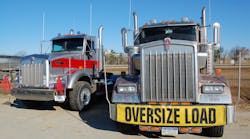Trucking fleets hoping that a reprieve from the driver shortage is around the corner will be disappointed in the latest research from employment screening firm HireRight. The company concluded that the truck driver shortage is set to worsen as freight demand rises and the workforce ages.
“The driver shortage is a significant problem, and while many industries are experiencing a talent shortage, trucking is unique in that it has several factors multiplying this challenge,” noted Steven Spencer, vice president of transportation.
Read more: ECTs: A solution for the driver shortage
The information is included in HireRight’s Transportation Spotlight 2015 report. Among the factors the firm noted are:
- Projections by the U.S. Bureau of Labor Statistics that compounded annual growth in employment for heavy and tractor-trailer truck drivers will reach 11.3% between 2012 and 2022;
- Yet the American Trucking Assn. (ATA) estimates that the current driver shortage tops 35,000 driver candidates, with an additional 240,000 new truck drivers needed by 2023 to keep up with freight growth;
- However, trucking is disproportionately dependent on employees 45 years of age and older. For instance, the median truck driver age in 2013 was 46.5 versus 42.4 for the overall U.S. workforce. Private carriers face a far higher median driver age of 52 years;
- The size of the core working age population (21 to 50) is shrinking, accounting for 41% of the workforce in 2000, and 38% today;
- Of the declining number of people working, fewer young people are considering blue collar careers.
Based on a broad poll of 3,119 human resources, talent management, recruiting, security and safety and executive level professionals from more than 2,494 unique organizations, HireRight said 19% of its total survey participants worked in the transportation industry, so the company’s analysis is based on their responses.
Eric Starks, president of research firm FTR Transportation Intelligence, added during a Fleet Forum presentation at the Mid-America Trucking Show (MATS) this year that other factors are affecting driver availability as well.
For starters, many new regulations due to come on line between 2017 and 2018 – especially the electronic logging device (ELD) mandate – means more drivers will be needed to offset productivity losses, By FTR’s reckoning, some 1.2 million to 1.5 million more drivers will be needed within the next two to three years just to cover productivity losses due to more regulatory oversight.
“We always have driver shortage when economy picks up, but the added regulations between 2014 and 2016 – especially hours of service (HOS) revisions – now means the [driver] shortage is systemic, even when the economy slows,” Starks said.
HireRight noted that the main rulemaking efforts for the next five years likely will revolve around the following initiatives:
- Entry-level driver training standards;
- Sleep apnea standards for screening, testing, treatment, and disqualifications;
- ELD mandates mandates;
- Speed limiters;
- Equipment standards;
- Revised safety fitness determinations for motor carriers;
- Increased insurance minimums.
FTR’s Starks added that traffic congestion also hurts trucking productivity and can also add to the demand for more drivers. “Every one mile per hour drop adds 67,000 more trucks to move same freight,” he explained.
In terms of driver turnover, HireRight said more than half (over 50%) of the individuals completing this year’s survey said their turnover rates are between 1% and 25% (much lower than the industry average) while 3% are experiencing turnover rates between 26% and 75%, while 9% had rates of 76% and above. Other survey findings along this line include:
- Companies with 4,000 or more employees had higher turnover rates than smaller organizations, with 31% reporting turnover greater than 75%.
- Conversely, almost three-quarters (72%) of organizations with one to 99 employees reported turnover rates ranging between 1% and 25% driver turnover rates.
- Historically the turnover rates for small truckload fleets have been much lower than larger carriers.
- However, trends are starting to show increased turnover rates in this segment as well; maybe due to improved pay and benefit packages offered by larger carriers.
HireRight also analyzed retention strategies among transportation industry participants in its survey and discerned that top four driver retention approaches are:
- Increasing pay (52%)
- Upgrading equipment (47%)
- Performance-based bonuses (45%)
- Recognition/reward programs (44%)
In terms of non-monetary retention activities, the top tactic for large companies (4,000 or more employees) are driver appreciation events (78%), while small carriers (one to 99 employees) are most likely to provide flexible work arrangements (49%), so drivers can spend more time at home, HireRight noted.
To keep drivers closer to home, 31% of all respondents employ dedicated operations, which benefit both the carrier and the driver, as carriers are guaranteed income during the contract period and drivers are given a standard route with set hours and more home time.
In addition, 13% told HireRight that they are conducting more “load swapping,” in which trucking companies relocate distribution centers or add more trailer yards so drivers can split long routes.
“Drivers can drop off their loads, pick up a new load, and head home, while the drop-off load is then picked up by another driver,” the firm added.
Leadership training and articulating career paths is used by 9% of respondents to help retain drivers, while 8% offer the ability to earn bankable home days, HireRight said.
Yet there is some good news to report as well, HireRight emphasized.
According to an ATA study of 130 fleets and more than 130,000 drivers found that median pay is ranging from just over $46,000 for national, irregular route dry van truckload drivers to more than $73,000 for private fleet dry van operators – on par with the national median for all U.S. households
And although turnover caused by driver retirements increased seven percentage points over the last year (29% in 2015 vs. 22% in 2014), if cost of living increases continue on their recent trend line, some retirement decisions may be deferred.



